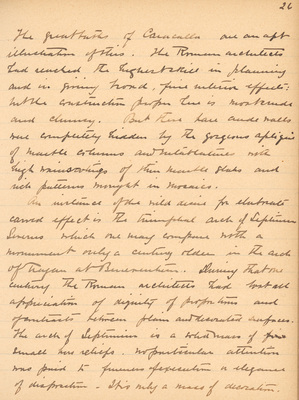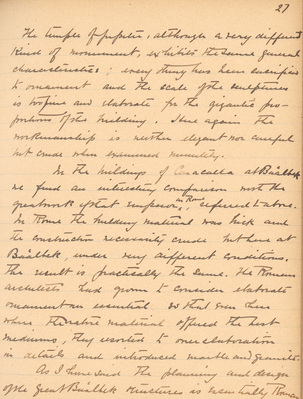Pages
BSY_FB_03-25
25
It is interesting to compare these monuments of classic Roman architecture with those of the same period which were built in the imperial city. In most places classic art had begun to decline. Roman artists had gone mad in striving to attain the most ornate effects and had sacrificed everything to secure them.
In Rome there was some excuse for this. The natural building materials had given out and the imperial builders were forced to fall back upon brick to carry out the monumental works of their masters. There was nothing in this artificial material to give a fine architectural effect and the architects were obliged to atone for the crudeness and heavyness of this construction by the use of a veneer of thin plates of rare marbles or mosaics and by giving a structural effect in enormous columns of marble and granite with entablatures richly carved. But in reality these details were only applied and had no real structural significance.
BSY_FB_03-26
26
The great baths of Caracalla are an apt illustration of this. The Roman architects had reached the highest skill in planning and in giving broad, fine interior effects; but the construction proper here is most crude and clumsy. But these bare crude walls were completely hidden by the gorgeous aplique of marble columns and entablatures with high wainscotings of thin marble slabs and rich patterns wrought in mosaics.
An instance of the wild desire for elaborate carved effect is in the triumphal arch of Septimus Severus which one may compare with a monument only a century older in the arch of Trajan at Beneventum. During that one century the Roman architects had lost all appreciation of dignity of proportions and of contrasts between plain and decorated surfaces. The arch of Septimus is a solid mass of small bas reliefs. No particular attention was paid to fineness of execution or elegance of disposition. It is only a mass of decoration.
BSY_FB_03-27
27
The Temple of Jupiter, although a very different kind of monument, exhibits the same general characteristics; everything has been sacrificed to ornament and the scale of the sculptures is too fine and elaborate for the gigantic proportions of the building. Here again the workmanship is neither elegant nor careful but crude when examined minutely.
In the buildings of Caracalla at Ba'albek we find an interesting comparison with the great work of that emperor in Rome referred to above. In Rome the building material was brick and the construction necessarily crude but here at Ba'albek, under very different conditions, the result is practically the same. The Roman architects had grown to consider elaborate ornament an essential so that even here where the native material offered the best mediums, they resorted to over elaboration in details and introdiced marble and granite
As I have said the planning and design of the great Ba'albek structures is essentially Roman.
BSY_FB_03-28
28
The designers had been trained under Roman influences but the construction bears no relation to the Roman structures in other parts of the world. The actual building must have been in the hands of natives for it is in all aspects a direct outcome of the building methods of the ancient Phoenicians in vogue at this time in all parts of Syria. The Romans themselves never resorted to megalithic construction even in their most colossal structures. It was only in the use of megalithic columns which they learned in Egypt that they ever approached this style; but here in Ba'albek their work partakes, to an extraordinary degree, of the constructive primciples common among the natives of Syria and tho' the blocks of stone used in their buildings here do not begin to equal in dimensions those used by the Phoenicians yet they are on a scale far greater than any used in these parts of the Roman world.
BSY_FB_03-29
29
All this is simply to illustrate how the Romans carries their artistic concenptions, their ideas of planning, their arch, wherever they went; but great engineers as they had been in the past and still were along certain lines, they were willing to learn from their subjects whatever was fine in native arts.
The temples of Ba'albek ther are huge structures designed on Roman lines but constructed upon Phoenician building principles.





